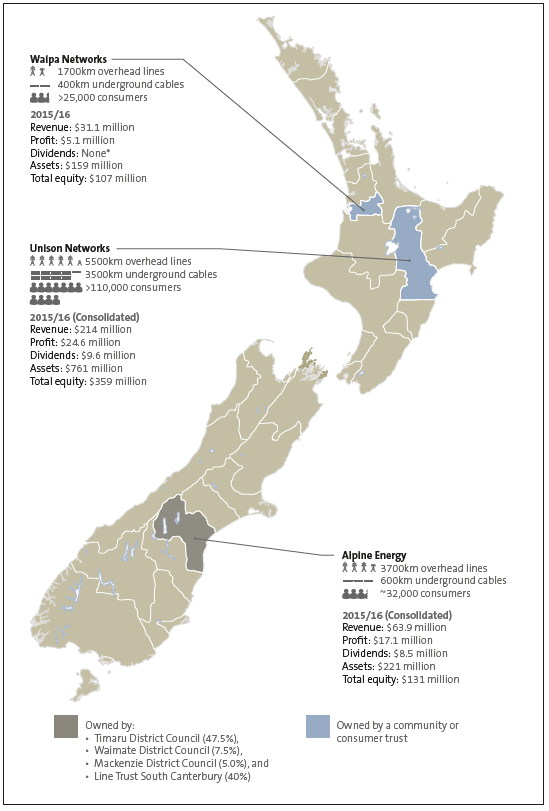Part 1: Introduction
1.1
The energy sector in New Zealand is diverse and made up of a mixture of public and private entities. Most of the public entities in the energy sector are electricity distribution businesses responsible for distributing electricity to consumers.
1.2
In June 2016, we released a report on the results of 2014/15 energy sector audits.1 The report outlined the trends we saw from the audits of electricity distribution businesses. We emphasised that electricity distribution businesses are asset-intensive entities that must plan and carry out effective asset management. Electricity networks require continuous replacement and upgrading to ensure a safe and reliable supply of power.
1.3
In this report, we examine the asset management practices of electricity distribution businesses. Although other organisations2 have carried out some analysis of electricity distribution businesses' asset management plans, we have focused on how those plans are put into practice.
1.4
We wanted to look at how electricity distribution businesses were managing and maintaining their assets and, in particular, how they were investing in their networks to ensure that they could continue to deliver the services required.
1.5
We reviewed the asset management practices of three electricity distribution businesses (the three companies): Alpine Energy Limited (Alpine), Unison Networks Limited (Unison), and Waipa Networks Limited (Waipa). Figure 1 shows the locations and overviews of the three companies. Background information about each company is in the Appendix. We chose these companies after considering the financial information prepared by all electricity distribution businesses. We also looked at other information, such as who owns the businesses and where they are located. Although we reviewed the practices of only three companies, we encourage all electricity distribution businesses to consider whether our findings also apply to them.
1.6
We focused on three aspects of asset management:
- Entity capability:
- how the three companies govern the management of their network assets;
- the three companies' resourcing strategies for asset management and their approaches to training and developing staff; and
- the risk management strategies and formal reporting about risks.
- Asset knowledge, maintenance strategies, and resilience:
- how well the three companies understand the distribution assets they own and the condition and performance of these assets;
- the approaches the three companies take to maintain and replace assets and the trends we saw from what they forecast in the short and long term; and
- how the three companies ensure that their networks are resilient.
- Network adaptability:
- what the three companies are doing in response to changing technologies.
Figure 1
Location and overview of Alpine Energy Limited, Unison Networks Limited, and Waipa Networks Limited

* Although Waipa did not pay any dividends to its shareholders in 2015/16, it did provide $4 million in line revenue discounts to individual customers.
1.7
Our findings are based on interviews with staff and a review of documents, such as the three companies' asset management plans.
The structure of this report
1.8
Part 2 sets out our analysis of financial information prepared by electricity distribution businesses for the period 2011/12 to 2015/16. We describe what this tells us about their financial health and investments in their networks.
1.9
Part 3 examines the three companies' asset management capabilities.
1.10
Part 4 examines the three companies' asset knowledge, maintenance strategies, and network resilience.
1.11
Part 5 examines the three companies' network adaptability.
1: Office of the Auditor-General (2016), Energy sector: Results of the 2014/15 audits, Wellington.
2: Most notably, the Commerce Commission carried out reviews of electricity distribution businesses' asset management plans to assess compliance with the Commission's expectations. The most recent review, for the 2011-21 asset management plans, is available on the Commission's website.

